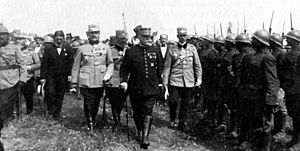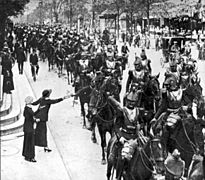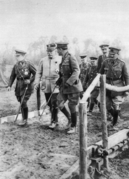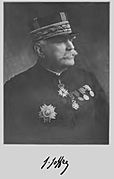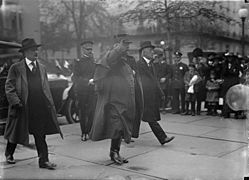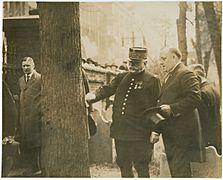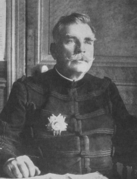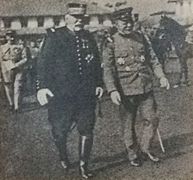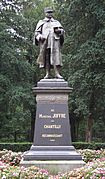Joseph Joffre facts for kids
Quick facts for kids
Marshal
Joseph Joffre
|
|
|---|---|
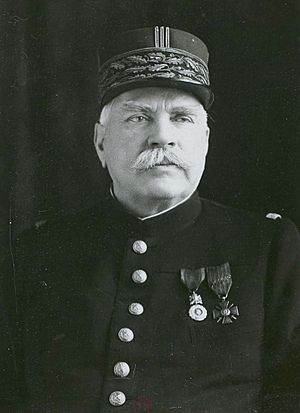
General Joffre, unknown date
|
|
| 23rd Chief of the Army Staff | |
| In office 29 July 1911 – 14 December 1916 |
|
| Preceded by | Augustin Dubail |
| Succeeded by | Robert Nivelle |
| Personal details | |
| Born | 12 January 1852 Rivesaltes, French Republic |
| Died | 3 January 1931 (aged 78) Paris, French Republic |
| Nationality | French |
| Spouses |
Amélie Pourcheyroux
(m. 1873; died 1874)Henriette Penon
(m. 1905) |
| Parents |
|
| Alma mater | École Polytechnique |
| Military service | |
| Allegiance | |
| Branch/service | French Army |
| Years of service | 1869 – 1916 |
| Rank | Division general |
| Commands |
List
|
| Battles/wars |
List
|
Joseph Jacques Césaire Joffre (born January 12, 1852 – died January 3, 1931) was a famous French general. He led the French armies on the Western Front from the start of World War I until the end of 1916. He is best known for bringing together the retreating Allied armies to stop the Germans at the very important First Battle of the Marne in September 1914.
After 1915, his power decreased because of unsuccessful attacks and the tough German attack on Verdun in 1916. Also, the Anglo-French attack on the Somme in 1916 did not go as well as hoped. At the end of 1916, he was promoted to Marshal of France, a very high rank. He then moved to an advisory role but soon resigned. Later in the war, he led an important mission to the United States.
Contents
Early Life and Military Career
Joffre was born in Rivesaltes, France, into a family who owned vineyards. He joined the École Polytechnique in 1870 and became a professional army officer. His first experience in battle was as a young artillery officer during the Siege of Paris in the Franco-Prussian War.
After this war, he trained more and then joined the engineers. Joffre spent much of his career as a military engineer in French colonies. He served well in the Keelung Campaign during the Sino-French War (1884–1885). As a major, he led a group of soldiers to Timbuktu in Mali. During this mission, his forces fought against the Tuareg and captured many cattle. This success led to his promotion. He also served in Madagascar and was promoted to general there.
In 1903, Joffre returned to France to command a cavalry brigade. The next year, he became the Director of Engineers in Paris. In 1905, he was promoted to Général de division, which was the highest rank in the French Army at that time. He then commanded an infantry division and worked as an inspector for military schools. From 1908 to 1910, Joffre commanded the 2nd Army Corps.
In July 1911, the Minister of War, Adolphe Messimy, changed the leadership of the French Army. General Victor-Constant Michel, who was supposed to be the Commander-in-Chief, was removed because he suggested a defensive plan if war with Germany happened. Messimy decided to combine two important roles into one, creating a single professional head of the Army. This new powerful position was offered to other generals first, but they declined. So, Joffre was appointed to this important role.
Joffre helped to rebuild the army and removed officers who were seen as too defensive. He adopted a plan called Plan XVII, which was developed by Ferdinand Foch. Joffre was chosen for this command even though he had never led a large army before and didn't have much experience with General Staff work. In 1914, a new government came to power, and Joffre was supposed to be replaced later that year. However, World War I began before this change could happen.
Joffre in World War I
1914: The Start of the War
The Battle of the Frontiers
When World War I began, the French plan for war clashed with Germany's Schlieffen Plan. This caused problems for the French. On August 15, after German cavalry were seen near Dinant, Joffre issued an order saying that the main German attack would come through Belgium.
Joffre knew that many German troops were moving through Belgium. However, he believed that only a few would come west of the Meuse River, where he thought the British and Belgians could stop them. The French Third and Fourth Armies were getting ready to attack into the Ardennes forest. Joffre wanted the French Fifth Army to attack the main German forces from the west.
On August 19 and 20, the French First and Second Armies attacked into Alsace-Lorraine. They were pushed back with heavy losses by German forces. Joffre still believed that the city of Liège was holding out, and he hoped that the French Fifth Army could reach Namur. The Germans entered Brussels on August 20. Despite the defeats and reports of strong German forces in Belgium, Joffre was convinced that the German center in the Ardennes must be weak. On August 21, the French Second Army was attacked by a German counterattack. General Castelnau asked to leave Nancy, but Joffre told him not to.
As the French Third and Fourth Armies attacked into the Ardennes, their infantry moved faster than their artillery. Meanwhile, the German Second Army attacked the French Fifth Army, forcing them to cross the Meuse River. The Fifth Army was also attacked by the German Third Army. Although these attacks were held, the commander of the Fifth Army asked Joffre for permission to retreat. On August 23, the Fifth Army was attacked again.
On August 23, Joffre reported to the war minister that his Fourth Army was pushing into the Ardennes. He wrongly believed they had more soldiers there. In his memoirs, Joffre later admitted he was mistaken. At the time, he demanded that the French Fourth Army continue their attack. He also asked for a list of officers who were not performing well, so they could be dismissed. The war minister fully supported Joffre in removing these generals.
The Great Retreat
On August 25, Joffre decided against a suggestion to order the French Fifth Army to attack westwards. Instead, he had plans made for French troops to gather at Amiens. Many of these troops were moved from the French right side in Alsace. He also ordered successful counterattacks by the Third Army to stop. General Michel-Joseph Maunoury was put in charge of the new Sixth Army, which first gathered near Amiens and then moved back towards Paris.
Joffre was worried by reports that the British had been defeated and needed French help. On August 27, Joffre gave a direct order to the Fifth Army to counterattack as soon as they were in open ground. After some disagreement, Joffre visited the commander and ordered him to attack to the west.
The French Fourth Army, which was supposed to lead the attack into the Ardennes, was strong and had made several counterattacks. But Joffre now ordered it to stop attacking. He sent a group of soldiers under Ferdinand Foch to cover the gap between the Fourth and Fifth Armies. This group became the new Ninth Army.
Joffre went to the headquarters of the Fifth Army to oversee the Battle of Guise on August 29. He was ready to remove the commander if needed. However, he was impressed by how calmly the commander handled the battle. Because of this battle, the German First Army stopped its attacks on the French Sixth Army and moved south-east, away from Paris.
The Miracle of the Marne
On August 25, the war minister ordered Joffre to send three army corps to defend Paris. Joffre ignored this, seeing it as interference. On August 26, a new government was formed. On August 27, the new war minister visited Joffre. Joffre promised to provide the three corps for Paris if the French attack near Amiens failed.
On August 30, Joffre suggested that the French government leave Paris. He also learned about a big Russian defeat. On September 1, the French Fifth Army retreated across the Aisne River. Joffre issued a new order, placing the Sixth Army under the command of Joseph Gallieni, who was the military governor of Paris. He also formed a new cavalry unit to fill the gap between the Fifth Army and the British forces.
On September 2, the government left Paris for Bordeaux. That day, Joffre put the Sixth Army directly under Gallieni's command as the "Armies of Paris." Joffre planned to retreat behind the Seine River before counterattacking. He imagined a big battle, likely around September 8, between Paris and Verdun. On September 3, he replaced the commander of the Fifth Army with a more aggressive general.
On the night of September 3–4, Joffre sent a note to Gallieni, wanting the Sixth Army to push east along the north bank of the Marne River. On September 4, Gallieni learned that the German First Army was marching south-east across Paris. Gallieni then called Joffre, suggesting an attack north of the Marne on September 6 or south of the Marne on September 7.
Joffre's reply, saying he preferred the southern option, arrived too late for Gallieni. That same afternoon, British officers were discussing plans with the French Fifth Army, which involved the Sixth Army attacking north of the Marne.
Without news from the Fifth Army, Joffre ordered plans for the Sixth Army to attack south of the Marne on September 7. This plan was also shared with the British commander, Sir John French. While Joffre was having dinner, a message arrived saying that the Fifth Army would be ready to attack on September 6. At this point, Gallieni insisted on speaking to Joffre directly. He told Joffre it was too late to cancel the movement of the Sixth Army. Joffre agreed to move the Allied attack forward to September 6 and have the Sixth Army attack north of the Marne instead. Later, Joffre wrote that he did this reluctantly. At 10 PM, Joffre issued General Order No 6, ordering a general Allied offensive. This became known as the First Battle of the Marne, a crucial victory that saved Paris.
On September 7, Gallieni was ordered not to communicate directly with the government. This left Joffre with great power, as he had replaced many generals, making Gallieni his only serious rival. By early December 1914, Gallieni was being considered as a possible replacement for Joffre.
1915: Continued Fighting
Spring Offensives
On January 7, 1915, President Poincaré supported a plan for an expedition to Salonika, despite Joffre's opposition. Poincaré hoped this would cause Turkey and Austria-Hungary to leave the war, leaving Germany isolated.
Joffre planned another major attack in the Artois in spring 1915. He told British officers that he would be ready to break the German line by the end of April. In May, he even spoke of reaching Namur and ending the war in three months.
Joffre's Authority Expands
The French government faced problems after an unsuccessful autumn attack and Bulgaria joining the war. The Prime Minister asked Joffre if Gallieni would be a good replacement for the war minister. Joffre replied, "Perhaps." In the end, a new government was formed on October 29, 1915, with Gallieni as war minister.
As early as July 1915, Joffre had asked to be appointed commander-in-chief over all French forces, including those fighting at the Dardanelles. By November, he was again pushing for this, or for a strong war minister with a strong chief of staff. The President was convinced by Joffre's argument.
At a meeting on November 24, 1915, Joffre insisted on clarifying his authority compared to Gallieni's. He also objected to the council discussing battle plans, threatening to resign if they interfered with his freedom to command. Gallieni, who wanted a strong war ministry, complained that politicians were unwilling to stand up to Joffre. On December 1, Gallieni agreed that Joffre should be commander-in-chief. A presidential order on December 2 made Joffre "Commander-in-Chief of the French Armies" (generalissimo). This was approved by the French Parliament. Joffre now commanded forces on the Western Front and at Salonika. However, there was still tension with Gallieni over who could appoint generals and Joffre's direct communication with British generals.
In autumn 1915, a member of Parliament complained to Gallieni that Joffre had been removing guns and soldiers from Verdun and even preparing some forts for demolition. Joffre was very angry and questioned Gallieni's right to comment. The government discussed these reports, and Gallieni was asked to investigate. Gallieni wrote to Joffre, expressing concern about the state of the trenches at Verdun.
1916: Challenges and Changes
The Battle of Verdun
The British government agreed to keep troops at Salonika to please the French, even though they doubted it would bring Greece into the war. Arguments continued with Joffre throughout 1916. In March 1916, Joffre and the Prime Minister blocked a British proposal to withdraw some British divisions from Salonika.
After months of talks, Joffre and the British commander, Sir Douglas Haig, agreed on February 14, 1916, to a joint Anglo-French attack on the Somme. However, the German attack on Verdun began on February 21, which reduced the number of French troops available for the Somme.
In August 1915, the French General Staff had decided to remove some weapons from the Verdun forts. They wrongly believed these forts could not withstand modern heavy artillery. The Germans initially made good progress against these weakened forts. Fort Douaumont, a key part of the Verdun defenses, was given up without a fight. It became a base for German forces. One French general said its loss would cost the French army many lives.
Joffre's political position was already weaker after the huge losses of 1915. Now, rumors spread in Paris that Joffre had ordered Verdun to be abandoned when the Germans first attacked. Gallieni demanded to see all documents from that time. Joffre had not given such an order in writing, but had sent a general to assess the situation.
The political situation became very difficult. Gallieni presented a critical report to the government on March 7, criticizing Joffre's leadership. He then resigned. It is not clear if he was trying to get Joffre removed. To save the government, General Pierre Roques was appointed war minister after Joffre confirmed he had no objections. Joffre himself had been considered for the job.
The Somme Offensive
In early 1916, Joffre asked the British commander, Sir Douglas Haig, to speak well of him to the British ambassador in Paris, hoping it would reach the French government. General Haig wanted to delay the Anglo-French attack at the Somme until August 15 to allow for more training and artillery. When told this, Joffre reportedly shouted that "the French Army would cease to exist" and had to be calmed down. The British refused French demands for a joint attack from Salonika. Eventually, Haig agreed to attack at the start of July. This was just in time, as the commander at Verdun was warning the French government that they might lose unless the British attacked.
Joffre and the British general Robertson agreed at a meeting in November 1916 to focus on the Western Front in 1917, rather than sending more resources to Salonika.
Joffre's Removal from Command
The fall of Bucharest (December 6, 1916) meant that a joint attack on Bulgaria was no longer possible. It also opened the way for a Central Powers attack on Salonika. One of Joffre's last official duties was to order the French commander in Salonika to stop his attack and set up a strong defense. To the surprise of Joffre and the Prime Minister, the war minister returned from a trip to Salonika recommending that the commander there be reinforced and no longer report to Joffre. This report, along with the disappointing results of the Somme campaign and the fall of Romania, further weakened Joffre's position.
On December 13, a new government was formed. Joffre was appointed "general-in-chief of the French armies, technical adviser to the government." Robert Nivelle became commander-in-chief of the Armies of the North and Northeast. Joffre was confused about his new role. He felt it was not what he had been promised. He soon found that he had no real power. On December 26, the day he was promoted to Marshal of France, he asked to be relieved of his duties. Joffre was still popular and was the first person to be promoted Marshal under the Third Republic.
After the War
On April 1, 1917, Prime Minister Ribot asked Joffre to join a mission to the United States. A similar British mission was also being prepared. The French and British had been getting ready for this since February, expecting the United States to declare war on Germany. Joffre was at first hesitant to go because a major French offensive was underway. On April 6, the United States Congress declared war on Germany. The main challenge for the new American army would be training soldiers and officers. Joffre initially thought about suggesting that US companies and battalions join the French and British armies, but he realized the Americans would never agree to this.
The group sailed to the US, trying to get along with reporters on board. Joffre landed on April 24 and was welcomed by American officials. He arrived in Washington the next morning and met with the Secretary of State and other important figures. Joffre stayed in Washington for ten days and spoke to both houses of Congress. On April 27, he met the US Army Chief of Staff. Joffre recommended sending a single American unit to France right away. He also asked the Americans to send railroads, cars, and trucks for the French Army.
Joffre left a paper arguing for a separate American force. Then, on May 4, he began a week-long tour of the eastern US. He visited historical sites and laid wreaths at statues. He returned on May 10 to find that the US authorities agreed with his recommendations. The 1st US Infantry Division, made up mostly of regular soldiers, was to be sent in early June. On the last day of his visit to Washington, the Secretary of War introduced him to General John J. Pershing, who had just been chosen to command the American Expeditionary Forces (AEF). Joffre told him that he could always count on his help.
On June 13, Pershing met Joffre and other French leaders in Paris. Joffre suggested that an American unit be quickly sent to France to show the flag. The 2nd Battalion, 16th Infantry Regiment was sent. Joffre and President Poincaré reviewed them as they marched up the Champs-Élysées on July 4.
Joffre became a leader of the Supreme War Council in 1918. When he retired in 1919, he became a member of the Académie française, a famous French institution. In 1920, he led a Catalan literary competition in Barcelona.
In 1922, he was welcomed in Broadway, New York, with a ticker-tape parade.
Death
Joffre died in Paris on January 3, 1931, at the age of 78. His body was buried on his estate at Louveciennes. His memoirs, which are his personal writings about his life, were published after his death in 1932.
Joffre's Personality and Impact
Joffre was not religious and had been a freemason since 1875. This was different from many French generals who were Catholic and sometimes viewed with suspicion by the Third Republic.
Joffre was generally quiet and had a very calm nature, though he could sometimes become very angry. He would sometimes visit a unit's headquarters, listen to reports, and then leave without saying much, which surprised the officers. During the Battle of the Marne, he relied heavily on his deputy chief of staff, General Henri Mathias Berthelot. The British commander, Sir John French, thought highly of him. Georges Boillot, a famous race car driver, was Joffre's personal driver in 1914.
General Hubert Lyautey believed Joffre was better at logistics (moving and supplying troops) than at strategy (planning battles). Joffre's main positive contributions in 1914 were his steady calm under pressure and his logical thinking. He was also known for his strict removal of unsuccessful generals, replacing them with strong leaders like Foch and Nivelle. He was excellent at managing the movement of French infantry divisions and artillery supplies during and after the French retreat in August 1914.
Historians note that while others played important roles in the Marne, the key decisions came from Joffre. He recovered from the early disastrous attacks and moved forces to the west. He remained calm when the first attempt to surround the German flank failed, requiring a retreat to Paris. During the Battle of the Marne, he handled problems faced by different French armies.
Historian John Eisenhower wrote that Joffre's personality had a big impact on history, and he became a well-known name in the United States.
Honours and Tributes
French Honours
- Legion of Honour: He received this high honour in several stages, from Knight in 1885 to Grand Cross in 1914.
- Médaille militaire – 1914.
- Croix de guerre 1914–1918 with Palm (a military award for bravery)
- Commemorative medal of the 1870–1871 War
- Tonkin Expedition commemorative medal – 1887
- Officer of the Order of the Dragon of Annam – 1887
- Colonial Medal – for service in Senegal and Sudan (1894)
- Jade Scepter of Emperor Khải Định of Annam – 1922
Foreign Honours
 Morocco:Grand Cross of the Order of Ouissam Alaouite of Morocco
Morocco:Grand Cross of the Order of Ouissam Alaouite of Morocco United Kingdom:Honorary Knight Grand Cross of the Order of the Bath (United Kingdom)
United Kingdom:Honorary Knight Grand Cross of the Order of the Bath (United Kingdom) United Kingdom:Order of Merit (United Kingdom)
United Kingdom:Order of Merit (United Kingdom) United States:Distinguished Service Medal (United States)
United States:Distinguished Service Medal (United States) Russian Empire: Order of St. George 2nd and 3rd class (Russian Empire)
Russian Empire: Order of St. George 2nd and 3rd class (Russian Empire) Siam:Knights Grand Commander (First Class) of the Order of Rama (1921, Thailand)
Siam:Knights Grand Commander (First Class) of the Order of Rama (1921, Thailand) :Doctor honoris causa (honorary doctorate) from Harvard University, and from the University of Porto and University of Coimbra (Portugal)
:Doctor honoris causa (honorary doctorate) from Harvard University, and from the University of Porto and University of Coimbra (Portugal) :Order of Karađorđe's Star with swords (Kingdom of Serbia)
:Order of Karađorđe's Star with swords (Kingdom of Serbia) :Grand Cross of the Order of the Tower and Sword of Portugal
:Grand Cross of the Order of the Tower and Sword of Portugal

Places and Things Named After Joffre
- The Joffre class of steam locomotives were French trains built during 1915 and 1916.
- A French aircraft carrier was being built with Joffre's name at the start of World War II, but it was never finished.
- When Joffre visited Romania in 1920, a famous bakery created the Joffre cake in his honour.
Many landmarks were named after Marshal Joffre: (a) France
- Place Joffre, Avenue de la Motte-Piquet, Paris, with a bronze statue of him on horseback.
- Avenue du Maréchal Joffre in Verdun.
- Rue du Maréchal Joffre in Nice.
- Boulevard Maréchal Joffre in Dijon.
- Avenue du Maréchal Joffre in Chantilly, France.
(b) Canada
- Mount Joffre, a mountain on the border of British Columbia and Alberta.
- Joffre Peak, a mountain in British Columbia.
- Joffre Street in Dartmouth, Nova Scotia.
- Rue Joffre (Joffre Street) in Shawinigan, Quebec.
- Avenue Joffre in Quebec City.
- Parc Maréchal-Joffre in Lévis, Québec.
- Joffre Avenue in Renfrew, Ontario.
- Pont Joffre (Joffre Bridge) in Sherbrooke, Québec.
(c) United States of America
- Joffre Street in Lowell, Massachusetts.
- Joffre, Pennsylvania, a small town.
- Joffre Avenue in Milltown, New Jersey.
(d) Australia
- Joffre Street in Pascoe Vale, Victoria.
(e) China (Mainland)
- Avenue Joffre (now Huaihai Road), located in the former French area of Shanghai.
(f) Romania
- Marshal Joffre Street (formerly Ion Mihalache Street) in Timișoara.
In 1918, Mount Joffre in Western Canada was named after him. Other nearby mountains are named after other French generals from World War I.
Gallery
-
French heavy cavalry, with armour, parading in Paris before heading to the front in August 1914
See also
 In Spanish: Joseph Joffre para niños
In Spanish: Joseph Joffre para niños
- Moroccan Division
- 2nd Marching Regiment of the 1st Foreign Regiment
- 2nd Marching Regiment of the 2nd Foreign Regiment
- Marching Regiment of the Foreign Legion
- Russian Expeditionary Force in France
- Non-US recipients of US gallantry awards


